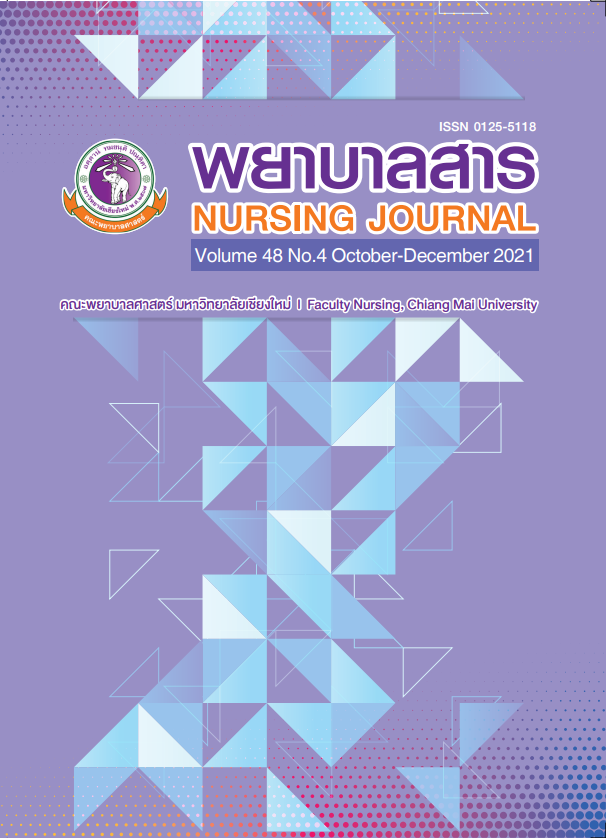Effect of Position and Pillow Support on Maternal Blood Pressure and Fetal Heart Rate Among Pregnant Women During Continuous Monitor Cardiotocography
Keywords:
Continuous monitor cardiotocography, Supine hypotension, pillow support, pregnancyAbstract
During continuous monitor cardiotocography pregnant woman have risk for supine hypotension that effect for utero placenta blood flow and risk for abnormal fetal heart rate pattern. This quasi-experimental research with two groups and repeated measurement design, aimed to determine the effect of position and pillow support on blood pressure level and fetal heart rate among pregnant women during continuous monitor cardiotocography, Chiang Rai Province. In this study, purposive sampling technique was used, seventy pregnant women with gestational age more than 36 weeks without complications during continuous monitor cardiotocography in two community hospitals, Chiang Rai Province were recruited. The samples were equally divided into an experimental group and control group, with 35 subjects in each group. The experimental group participated in the new intervention, semi-fowler’s position and pillow support, while the control group received routine care by adopting the normal position without pillow support during continuous monitor cardiotocography. Data were collected using a questionnaire to assess blood pressure level, pulse rate, fetal heart rate, and perception of comfort during continuous monitor cardiotocography. Data analysis was performed using descriptive statistics, independent t-test and one-way ANOVA. The results showed that after the intervention, the experimental group had higher mean blood pressure, and fetal heart rate than the pre-test and a higher value than the control group (p < .01). According to the continuous monitor cardiotocography, the experimental group had greater perceived comfortable than that of the control group (p < .05). The results of this study suggest that the change of new position and the pillow support during continuous monitor cardiotocography may prevent supine hypotension reduce the risk of abnormal fetal heart rate and increase perceived comfortable. Therefore, this intervention could promote during prenatal care.
References
Anusorntanawat, R. (2015). Incidence and risk factors associated with spinal anesthesia induced pre-delivery hypotension for cesarean section. Region 4-5 Medical Journal, 34(4), 267-279.
Cunningham, F., Leveno, K. J., Bloom, S. L., Dashe, J. S., Hoffman, B. L., Casey, B. M., Spong, C. Y. (Eds.). (2018). Williams Obstetrics. (25th ed.). New York: McGraw-Hill.
Faul, F. (2014). G*Power version 3.1.9.2 [Internet]. Retrieved from https://www.poycho.uni-duessldorf.de/abteilungen/aap/gpower3/
Ibrahim, H. A., Elgzar, W. T., & Saied, E. A. R. (2021). The effect of different positions during non-stress test on maternal hemodynamic parameters, satisfaction, and fetal cardiotocographic patterns. African Journal of Reproductive Health, 25(1), 81–89.
Khalifa, O. Y. A. (2019). Comparison of efficacy of different physical methods in preventing severe hypotension in cesarean deliveries in supine hypotension syndrome. Research and Opinion in Anesthesia & Intensive Care, 6, 108–111.
Kim, D. R, Sockol, L., Barber, J. P, Moseley, M., Lamprou, L., Rickels, K., O'Reardon, J. P, & Epperson, C.N. (2011). A survey of patient acceptability of repetitive transcranial magnetic stimulation (TMS) during pregnancy. Journal of Affective Disorders, 129(1–3), 385–390.
Kolcaba, K. (2003). Comfort theory and practice. New York: Springer Publishing.
Kunsiripunyo, J. (2019). Nurse’s roles in intrapartum fetal surveillance using
the continuous cardiotocography. Journal of Phrapokklao Nursing College, 30(1), 226-238.
Lee, S., Khaw, K., Ngan Kee, W., Leung, T., & Critchley, L. (2012). Haemodynamic effects from aortocaval compression at different angles of lateral tilt in non labouring term pregnant women. British Journal Anesthesia, 10(1)9, 950–956.
Monga, M., & Mastrobattista, J. M. (2014). Maternal cardiovascular, respiratory, and renal adaptation to pregnancy. In R. K. Creasy, R. Resnik, J. D. Iams, C. J. Lockwood, T. R. Moore, & M. F. Greene (Eds.), Creasy and Resnik’s maternal-fetal medicine principles and practice (7th ed). Philadelphia: Elsevier
Mukdasakunpiban, P., & Thammanupab, B. (2019). Effects of a program for prevention of hypotension in patients undergoing caesarean section under spinal anesthesia. Region11 Medical Journal, 33(1), 115-130.
Shahriari, A., Khooshideh, M., & Heidary, M. (2014). Prevention of hypotension during spinal anesthesia for caesarean section: Preload with crystalloids or hydroxyethyl starch. Med Hypothesis Discovery Innovation Interdisciplinary, 1(1), 1-20.
Thanafay, A., Suporn, C., Munchareng, S., Thongyod, P., Saithong, S., Prarom, S., & Onevicha, R. (2019). CHAN CHOA KHA pillows help comfortable and safety before baby delivery. 6th National Research Conference “Smart Society Development. Retrieved from http://61.19.238.50/PTU/images/journal/data/8-2-2019/4.pdf
Thongsong, T. (ed.). (2021). Obstetrics (6th ed.). Bangkok: Laxmirung.
Downloads
Published
How to Cite
Issue
Section
License
บทความที่ได้รับการตีพิมพ์เป็นลิขสิทธิ์ของวารสารพยาบาลสาร
ข้อความที่ปรากฏในบทความแต่ละเรื่องในวารสารวิชาการเล่มนี้เป็นความคิดเห็นส่วนตัวของผู้เขียนแต่ละท่านไม่เกี่ยวข้องกับมหาวิทยาลัยเชียงใหม่ และคณาจารย์ท่านอื่นๆในมหาวิทยาลัยฯ แต่อย่างใด ความรับผิดชอบองค์ประกอบทั้งหมดของบทความแต่ละเรื่องเป็นของผู้เขียนแต่ละท่าน หากมีความผิดพลาดใด ๆ ผู้เขียนแต่ละท่านจะรับผิดชอบบทความของตนเองแต่ผู้เดียว






